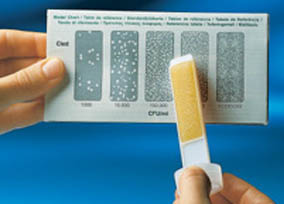Urinary bacteriology
The diagnosis and treatment of urinary tract infections is based on the bacterial count (CFU= colony forming unit), bacterial identification and on the determination of their sensitivity to different antibiotics. In recent years many simplified techniques have been developed for bacterial CFU counting. They are easily utilized in practice. When the number of CFU is abnormal, the sample is sent to a bacteriology laboratory for culture, identification and susceptibility testing.
Culture on agar paddle ("Uricult" ®)
The agar paddle is suitable for screening, transportation and culture. It is particularly useful when the specimen cannot be transported immediately and the sample cannot be refrigerated.
It is a variant of the traditional culture. Seeding should be done immediately after urination (within 20 minutes) by dipping the agar paddle into the urine. This prevents counting bacteria that might have multiplied during transport.
The plastic paddle can be covered with different agar culture media, usually a non-selective Cled-agar culture medium (all germs, Gram-positive and Gram-negative and yeast may grow after 48 hours), and a selective medium for Gram-negative bacteria, for example the McConkey-Agar, which allows the growth of most pathogenic bacteria and the initial classification of urinary germs.
There are several commercial versions of this system (Uricult ® is frequently used).
Diagnostic criteria in midstream urine
- CFU ≥105/mL = significant bacteriuria
A complete bacteriological analysis is indicated (culture, identification and sensitivity testing). - CFU 104 to 105/mL = grey zone
Complete bacteriological analysis if pure culture
Repeat analysis if mixed culture - CFU <104/mL = insignificant bacteriuria (possible contamination).
 |
 |
 |
 |
 |
|
Evaluate the bacterial count (CFU) by comparing the growth on the agar paddle with the manufacturer’s comparison scale. |
103/mL | 104/mL | 105/mL | 106/mL | |
| insignificant Bakteriurie (possible contamination) |
greyzone | significante bacteriruria | |||
| Images of Uricult® test procedure. With permission of the manufacturer, Orion Diagnostica (Espoo, Finland) | |||||